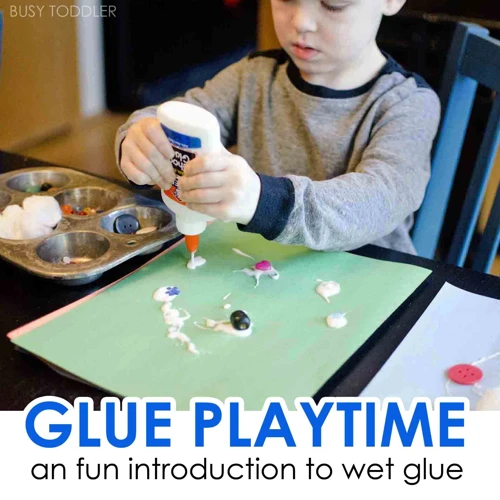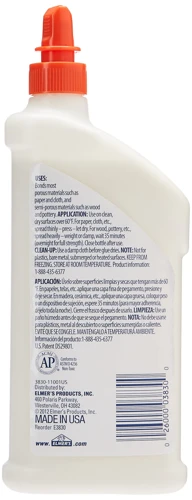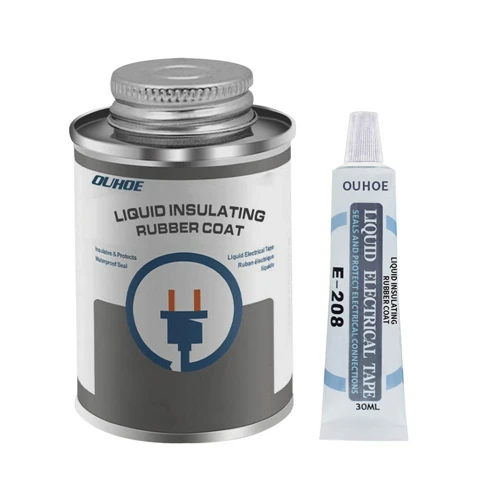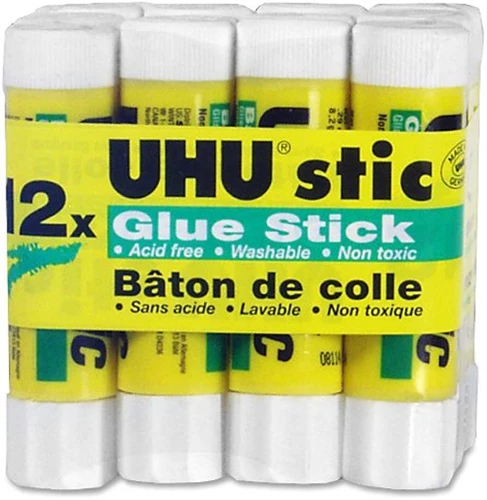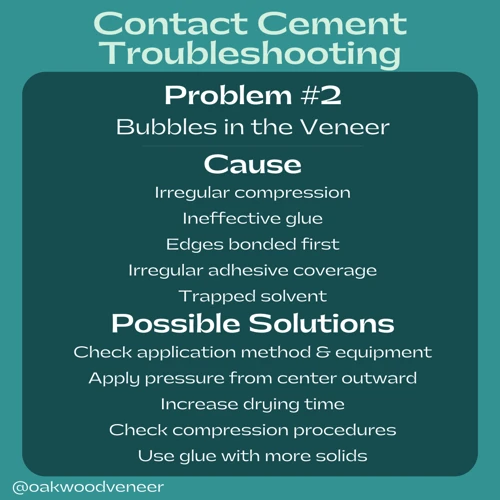Introduction
Have you ever been in a situation where a glue stick would have been a lifesaver, but there was none to be found? Learning how to make your own glue stick can be a useful skill to have. Not only is it cost-effective, but it allows you to control the ingredients used in your adhesive. In this comprehensive guide, we will discuss the science behind glue, the ingredients needed, necessary tools and safety measures, preparation steps, application tips, and even troubleshooting methods. By the end of this article, you’ll be a pro at making your own glue sticks!
The Science Behind Glue
The Science Behind Glue
Glue is a type of adhesive substance that bonds two surfaces together. It works by creating a bond between molecules through a process called cross-linking. Cross-linking occurs when chemical bonds are formed between the molecules of the adhesive and the molecules of the surface being bonded.
Different types of glue work in different ways. For example, some glues, such as cyanoacrylate glue, also known as super glue, work by reacting with moisture present on the surface being bonded. Other glues, like epoxy, require a hardener to be mixed with the adhesive to initiate the curing process.
Table: Common Types of Glue and How They Work
| Type of Glue | How They Work |
|---|---|
| Cyanoacrylate glue (super glue) | Works through a reaction with surface moisture to create a strong bond. |
| Epoxy | Requires a hardener to be mixed with the adhesive to initiate cross-linking. |
| Polyvinyl acetate (PVA) glue | Bonds surfaces together when the water evaporates from the glue, leaving behind a strong adhesive bond. |
| Hot melt adhesive | Works by melting the adhesive and then cooling it, which creates a strong bond. |
The strength of the bond created by glue depends on various factors, including the type of glue, the surfaces being bonded, and the amount of pressure applied during the bonding process. Different types of glue are better suited for certain materials. For example, hot glue is great for bonding porous surfaces like fabric, while epoxy is best for bonding metal and plastic surfaces.
Understanding the science behind glue can help you choose the right type of adhesive for your project and ensure a strong and long-lasting bond. For more information on using glue in unique ways, check out our article on how to use glue in Minecraft.
Ingredients
Ingredients for Making Homemade Glue
One of the great benefits of making your own glue stick is that you have full control of the ingredients that you use. This means that you can ensure that the adhesive you create is safe, effective, and perfect for your specific project. In this section, we will explore the various ingredients that you can use to make your own glue stick, including common adhesives and additional ingredients that can enhance the strength and durability of your homemade glue. For those who are wondering how strong is glue gun for their project, check out our article How Strong is Glue Gun? for more information!
Common Adhesives
When it comes to making your own glue stick, there are several commonly used adhesives that you can choose from based on your specific needs. Different adhesives have different strengths and weaknesses, so it’s important to choose the right one for your particular project. Here are some of the most common adhesives used in DIY glue stick making:
| Adhesive | Strength | Best For |
|---|---|---|
| PVA Glue | Medium | General purpose use, crafts, paper, wood |
| Epoxy | Strong | Metal, glass, ceramics, plastic |
| Super Glue | Very strong | Plastic, metal, ceramics, wood |
| Hot Glue | Strong | General purpose use, crafts, fabric, wood, plastic |
| Rubber Cement | Medium | Paper, cardboard, leather, fabric |
PVA glue is a versatile adhesive and a popular choice for general purpose use, as it works well with a variety of materials, including paper and wood. Epoxy is known for its ability to bond strong materials such as metal, glass, and plastic. Super glue is another strong adhesive that is commonly used in DIY projects, with a bonding power that can work wonders on plastic, metal, ceramics, and wood. Hot glue is a popular choice for crafts and fabric materials, as it bonds almost instantly and is easily removed if needed. Finally, rubber cement is a favorite for paper-based items such as cardboard and scrapbooking.
No matter which adhesive you choose, it’s important to follow the proper safety precautions and always use measuring tools to ensure the proper ratio of ingredients. If you’re unsure about which adhesive to use for your particular project, do some research or seek expert advice to avoid mistakes. If you’re looking for specific recommendations on the best adhesives to use for popular DIY projects, check out our guide on what glue to use for redneck wine glasses, tips for using hot glue to make elf ears, or our suggestions for gluing photos to wood.
Additional Ingredients
When it comes to making glue stick at home, there are a few additional ingredients that can enhance the adhesive’s strength, texture, and durability. Here are some options you can consider:
- White vinegar: Adding a few drops of white vinegar to your glue mixture can help improve its bonding strength. Vinegar works by dissolving any dirt, grease, or oil on the surfaces you’re trying to glue together, allowing the adhesive to hold onto the material better. This can be especially useful when working with porous materials like wood or fabric.
- Cornstarch: If you’re looking to create a thicker, more spreadable glue, try adding some cornstarch to the mix. Cornstarch acts as a thickening agent, helping your glue achieve a more gel-like consistency. This can be particularly helpful when working with vertical surfaces, as it can help prevent your glue from dripping or running.
- Baking soda: For a quick-drying glue recipe, consider adding a sprinkle of baking soda to the mixture. Baking soda acts as a catalyst, speeding up the chemical reaction between the water and glue. This can reduce drying time and help your adhesive bond faster. Just be sure to use baking soda sparingly, as too much can cause your glue to become brittle or prone to cracking.
- Food coloring: If you’d like to add a pop of color to your glue, consider mixing in a drop or two of food coloring. This can be a fun way to personalize your glue and make it more visually appealing.
Keep in mind that not all additional ingredients will be suitable for every glue recipe. It’s important to follow a reliable recipe and use only the ingredients recommended by the instructions. If you’re looking to use glue for a specific project, be sure to research the best glue type and application method. For example, if you’re working with popsicle sticks, you may want to check out this guide on what glue to use for popsicle sticks. Or, if you’re curious about glue stick bombs, you can learn more in our article on how to make a glue stick bomb. Whatever your project may be, make sure to take the necessary safety precautions and follow the proper procedures.
Tools and Safety
When it comes to making your own glue, having the right tools and taking safety precautions is crucial. You want to make sure that your workspace is properly equipped and that you are taking the necessary steps to protect yourself. In this section, we will cover the measuring tools and safety precautions needed for making glue. By following these guidelines, you can ensure that the process of making your own glue is not only successful but also safe. And if you’re wondering how long it takes for glue to dry on plastic or need tips on how to change glue gun stick later on, we’ve got you covered with helpful links.
Measuring Tools
Accurate measurement of ingredients is crucial for making glue that will stick effectively. When it comes to measuring tools, it’s important to have precise instruments on hand. One of the most essential tools you will need is a digital scale. It’s important to measure by weight rather than volume since different materials have different densities.
In addition to a digital scale, measuring cups and measuring spoons are also necessary. Measuring cups are used to measure larger quantities of ingredients, such as water, while measuring spoons are for smaller amounts. Pipettes might also be needed for precise measurement of liquids.
It is important to make sure that all of these measuring instruments are clean and dry before using them to measure ingredients. A single unwanted substance on the instrument can throw off an entire batch of glue.
Now, if you need to change your glue stick mid-project, check out our guide on how to change glue gun stick. Or, if you need to glue your headphones back together, read our tips for a successful repair. And if you’re wondering how long hot glue takes to dry on plastic, check out our drying time guide.
Safety Precautions
When making glue sticks, it is essential to take certain precautions to ensure that the process is safe. Here are some safety precautions to keep in mind:
| Precaution | Description |
|---|---|
| Wear protective gear | When handling the ingredients, it is recommended to wear gloves and protective eyewear to prevent any accidental exposure to the chemicals. |
| Work in a well-ventilated area | When heating the ingredients, it is important to work in a well-ventilated area to prevent harmful fumes from accumulating. |
| Use heat-resistant tools | Make sure to use heat-resistant tools when mixing and heating the ingredients to prevent them from melting or deforming. |
| Avoid contact with skin and eyes | The chemicals used in making glue sticks can be harmful if they come into contact with the skin or eyes. Take care to avoid getting the ingredients on your skin or in your eyes. If any of the ingredients do come into contact with your skin or eyes, immediately rinse with water and seek medical attention if necessary. |
| Keep out of reach of children and pets | Since the ingredients used in making glue sticks can be harmful if ingested, it is important to keep them out of reach of children and pets who may accidentally ingest them. |
By following these safety precautions, you can ensure that the process of making glue sticks is safe for both you and those around you.
Preparation
Before you start making your own glue stick, it is important to gather all the necessary ingredients and tools, and take note of the safety precautions. The preparation process includes careful measuring and precise heating of the mixture to ensure the glue stick is smooth and evenly blended. In this section, we’ll go over the step-by-step process of preparing the glue mixture, as well as some troubleshooting tips in case you encounter any issues. So let’s roll up our sleeves and get started on making your own personalized and eco-friendly glue stick!
Mixing Guide
Mixing the correct proportions of ingredients is crucial in creating a strong and effective glue stick. Here is a step-by-step guide to mixing your ingredients:
- Prepare your workspace: Before you begin mixing, make sure to clear your workspace of any unnecessary items or clutter. This will give you enough space to work and prevent any accidents or spills.
- Measure your ingredients: Use a digital scale to measure your ingredients in grams or milliliters, whichever your recipe calls for. Follow the recipe carefully to ensure you have the right proportions of each ingredient.
- Combine your ingredients: In a mixing bowl, combine all the dry and liquid ingredients. Use a spoon or spatula to mix them together until they are evenly combined. Be sure to scrape the sides and bottom of the bowl to make sure there are no lumps of unmixed ingredients.
- Mix thoroughly: Once all the ingredients are combined, use an electric mixer to beat the mixture until it becomes smooth and creamy. This process typically takes 2-3 minutes but can vary depending on the recipe and type of mixer you are using.
- Heat the mixture: Depending on the recipe, you may need to heat the mixture to melt the ingredients together. Use a double boiler or a microwave-safe container to heat the mixture slowly. Be sure to stir the mixture frequently to prevent burning or overheating.
- Cool the mixture: After the mixture is heated, allow it to cool to room temperature. This will help the mixture thicken and become more viscous, making it easier to apply to surfaces.
Remember to follow your recipe carefully and use high-quality ingredients to create the best glue stick possible. Mixing the ingredients properly is just the first step in the process. Proper application and storage are also crucial to ensuring that your glue stick remains effective and long-lasting.
Heating Guide
When making glue stick, heating is an essential process that can strongly impact the quality of the adhesive. The process of heating the ingredients together is what creates the physical bonding process that makes glue so effective. Here is a guide on how to heat your ingredients for maximum effectiveness:
| Ingredient | Heating Method | Temperature | Time |
|---|---|---|---|
| Melt the Wax: | |||
| Beeswax or Candle Wax | Microwave or Double Boiler | 160-180°F | 10-20 minutes |
| Combine Ingredients: | |||
| Wax and Glue Mixture | Double Boiler | 140-160°F | 30-45 minutes |
| Water (if required) | Kettle or Heat Plate | ~212°F | 1-2 minutes |
When heating the wax, it’s important to do so slowly and evenly to prevent burning or boiling, so use a microwave or double boiler to heat it up gradually. The temperature range should be between 160-180°F for a maximum of 20 minutes, depending on the type of wax being used.
When combining the wax and glue mixture, it’s important to use a double boiler to keep the temperature stable and consistent. The temperature should be between 140-160°F and should be heated for around 30-45 minutes to ensure that all the ingredients have melted and combined perfectly.
If your recipe requires water, heat it separately in a kettle or heat plate to around 212°F for 1-2 minutes and slowly pour it into the wax and glue mixture, stirring quickly and continuously.
By following this heating guide, you can be certain that your glue stick will have the perfect consistency and strength to provide a long-lasting bond for any project you tackle!
Application
When it comes to using the glue you’ve made, proper application is key. The strength and effectiveness of your adhesive will largely depend on how well it is applied to the surface. In this section, we’ll explore the best practices for using your homemade glue, including surface preparation and various types of applications. By following these tips, you’ll be able to ensure a strong and long-lasting bond for all of your DIY projects. Let’s dive in!
Surface Preparation
Before applying glue, it is important to prepare the surface properly to ensure that the adhesive can properly bond with the material. Here are some key steps you should follow when preparing surfaces for glue application:
Clean the surface: The first step is to ensure that the surface is clean and free of any dirt, dust, or debris that can prevent the adhesive from bonding properly. Use a damp cloth to wipe the surface clean, and allow it to dry completely before applying the glue.
Sand the surface (if necessary): Sometimes the surface may be too smooth to allow the adhesive to properly bond. In such a case, you can use sandpaper to roughen the surface and provide a better grip for the adhesive. Use a fine grit sandpaper to avoid making rough scratches on the surface that may be difficult to cover up later.
Apply primer (if necessary): When working with surfaces that are porous or difficult to bond with, it may be necessary to apply a primer before applying the glue. The primer helps the adhesive to penetrate the surface and form a stronger bond. Be sure to carefully follow the instructions that come with the primer to ensure that you are using it correctly.
Once you have prepared the surface, it is important to apply the glue evenly and with care to ensure that it bonds properly. Incorrect application of glue can lead to weak bonds or even damage to the materials you are trying to join. This is why it’s important to follow all instructions regarding glue application and to use the appropriate tools and techniques for the job.
To summarize, surface preparation is a crucial step in the glue making process. By following these steps, you can ensure that the glue bonds correctly and your project is a success.
| Steps | Explanation |
|---|---|
| Clean the surface | Ensure that the surface is clean and free of any dirt, dust, or debris that can prevent the adhesive from bonding properly. |
| Sand the surface (if necessary) | Use sandpaper to roughen the surface and provide a better grip for the adhesive. Use a fine grit sandpaper to avoid making rough scratches on the surface that may be difficult to cover up later. |
| Apply primer (if necessary) | When working with surfaces that are porous or difficult to bond with, it may be necessary to apply a primer before applying the glue. The primer helps the adhesive to penetrate the surface and form a stronger bond. |
Types of Applications
When it comes to using homemade glue sticks, there are several different types of applications to consider. Each type of application requires a different technique for optimal results. Here are some common types of applications and how to tackle them:
| Application Type | Technique |
|---|---|
| Art Projects | To apply glue to smaller surfaces and intricate designs, try using a small paintbrush or a toothpick. This will help you achieve precision and avoid any excess glue. |
| Paper Crafts | A glue stick is the perfect tool for paper crafts, such as scrapbooking, card-making, or origami. Apply a thin layer of glue to the back of your paper and press it onto the surface you want to adhere it to. |
| Home Repairs | For larger surfaces, such as walls or furniture, apply the glue directly from the stick and spread it evenly with a putty knife or a brush. Make sure to use enough glue to create a strong bond. |
| Fabric Bonding | When bonding fabric, it’s important to choose a glue that is suitable for both materials. Apply a small amount of glue to one side of the fabric and press it onto the other fabric. Use a heavy object or a clamp to hold the fabrics together until the glue dries. |
By considering the type of application you need and the technique required for optimal results, you can make the most out of your homemade glue sticks. Always remember to test your glue on a small area before committing to a larger application. This will help you ensure that the glue is suitable for your project and that it will not cause any damage.
Troubleshooting
Sometimes, even when you have followed all the steps and instructions precisely, things can still go wrong when making glue stick. It can be frustrating to encounter problems such as inconsistent texture, clumping, or lack of adhesion. However, with a little troubleshooting and patience, these issues can often be resolved. In this section, we will explore common problems that can arise during the glue making process and provide effective solutions to help you achieve a successful outcome. Let’s dive in and tackle those pesky adhesive issues!
Common Problems and Solutions
When making your own glue stick, there are a few common problems that may arise during the preparation or application phase. Here is a list of some common problems and their solutions to help you troubleshoot and avoid frustration:
| Problem | Solution |
|---|---|
| Clumps or lumps in the adhesive mixture | This may be caused by improper mixing or heating. To fix this issue, try straining the mixture through a fine mesh sieve or cloth to remove any clumps. Next, try remixing the glue and reheating it to ensure that all ingredients are fully integrated. If the problem persists, you may need to start over with fresh ingredients. |
| The glue doesn’t stick well | If the glue is not sticking to the surface, it may be due to poor surface preparation. Make sure surfaces are clean, dry, and free from any residue or oils. Another possibility is that you did not apply enough glue. Try adding another layer of glue and letting it dry before attempting to attach the surfaces together. |
| The glue is too runny or too thick | The texture of your glue can be influenced by the heat and humidity of your working environment. If your glue seems too thin, try heating it for longer to reduce the amount of water content. If the glue is too thick, you may have overcooked it or added too much flour to the mixture. Try remixing with a bit of water or heat gently to soften it, respectively. |
| The glue is drying too quickly or too slowly | The rate of drying can depend on the temperature and humidity of the environment. If the glue is drying too quickly, try adding a small amount of glycerin to the mixture to slow the drying time. If it’s drying too slowly, try adding a bit more flour to thicken it up or increasing the amount of heat while cooking it. |
By understanding and addressing these common issues, you can perfect your glue-making skills and consistently produce a high-quality, effective adhesive for all your DIY needs.
Storage
After putting in all the work to make your own glue stick, you want to make sure it lasts! Proper storage is essential to keeping your homemade glue fresh and usable for future projects. No one wants to pull out their glue stick only to find it has dried up or gone bad. In this section, we will cover the best ways to store your homemade glue and ensure it stays in tip-top shape. Let’s dive in!
How to Make It Last
Once you’ve made your homemade glue, you’ll want to make sure it stays in good condition for future use. Here are some tips on how to make it last:
- Store in an airtight container: One of the most important factors in preserving your homemade glue is to store it properly. After making your glue, transfer it to an airtight container to protect it from air and moisture. Mason jars or plastic containers with tightly fitting lids work well.
- Keep in a cool, dry place: Another important factor to consider when storing your glue is the temperature and humidity of the room. Glue lasts longer when stored in a cool, dry place, away from direct sunlight or heat sources.
- Label the container: To avoid confusion and ensure you use the right glue for your project, label the container with the type of glue, date of creation, and any other relevant information.
- Check periodically: Even if stored properly, homemade glue can still deteriorate over time. To ensure that your glue is still usable, check it periodically for any signs of mold, discoloration, or separation. If you notice any of these, it’s best to dispose of the glue and make a fresh batch.
By taking these precautions, you can make sure your homemade glue stays in good condition and is ready to use when you need it.
Conclusion
The Final Verdict:
Making glue stick from scratch can be a fun and rewarding experience. It’s a great way to save some money and to gain a sense of satisfaction knowing that you made a high-quality adhesive that you can use for a range of projects.
The Importance of Experimentation:
Although this guide lays out a comprehensive recipe for making glue, it’s important to remember that the quality of your glue may vary depending on the specific ingredients and techniques that you decide to use. For example, adding more or less water might affect the strength and consistency of the glue stick.
Patience and Precision:
To ensure that your homemade glue stick is of the highest quality, it’s crucial to follow the recipe instructions carefully and to be patient throughout the mixing and heating process. Rushing through the steps and making mistakes can lead to inconsistent results and a lower quality adhesive.
Storage Tips:
Proper storage is also important for ensuring that your homemade glue stick lasts as long as possible. Be sure to store it in an airtight container in a cool, dry place, away from direct sunlight and heat sources.
Final Thoughts:
Overall, making your own glue stick is a fun and educational experience that can yield a high-quality adhesive that you can use for a range of projects. By following the step-by-step instructions laid out in this guide and experimenting with different techniques and ingredients, you’ll be able to create a glue stick that is tailored to your specific needs and preferences.
Frequently Asked Questions
1. Can I make glue stick without using heat?
Yes, you can use cold water to make glue stick. Simply mix the ingredients together and let the mixture rest for a few hours until it thickens to the desired consistency.
2. How long will homemade glue stick last?
Homemade glue stick can last for several months if stored properly in an airtight container. However, its shelf life may vary depending on the specific recipe you use.
3. Is it safe to make glue stick at home?
As long as you follow proper safety precautions, making glue stick at home is generally safe. However, it is important to protect your skin and eyes from the ingredients and to work in a well-ventilated area.
4. Can I use homemade glue stick for all types of materials?
This will depend on the type of glue stick you make and the materials you want to bond. Some homemade glue sticks may not work well for certain materials, so it is always best to test it out on a small area first.
5. How do I know if my homemade glue stick has gone bad?
If your glue has a foul smell or has become lumpy or discolored, it may have gone bad. In this case, it is best to discard it and make a fresh batch.
6. Can I make glue stick without using any chemicals?
Yes, you can make natural and chemical-free glue stick using ingredients such as flour, cornstarch, or milk.
7. What type of surface preparation is necessary before applying glue stick?
The surface should be clean and dry before applying glue stick. If the surface is porous, you may need to apply multiple coats of glue for a stronger bond.
8. Can I make colored glue stick?
Yes, you can add food coloring to your glue mixture to make colored glue stick.
9. How much glue stick should I apply?
The amount of glue stick you should apply will depend on the size and weight of the materials you are bonding. It is generally best to apply a thin, even layer for optimal results.
10. Can I use homemade glue stick for arts and crafts projects?
Yes, homemade glue stick can be used for a variety of arts and crafts projects, from paper crafts to DIY home decor.
